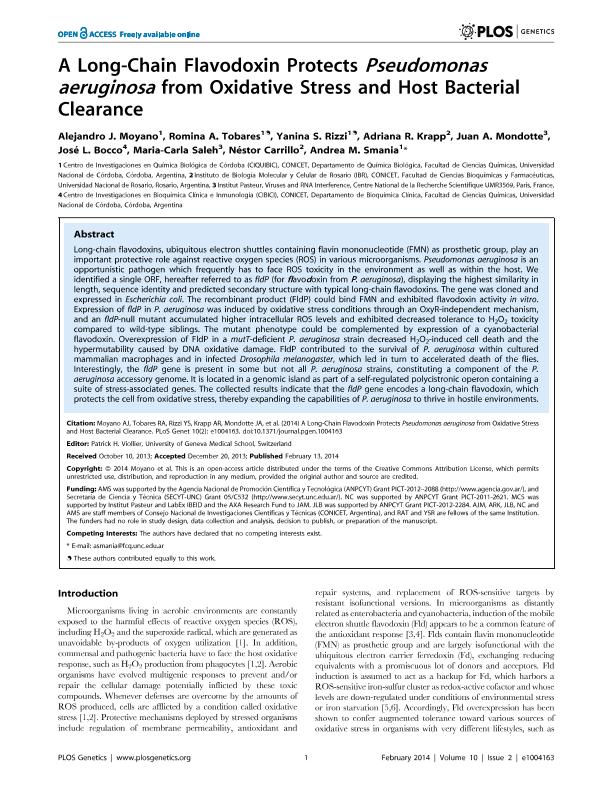Mostrar el registro sencillo del ítem
dc.contributor.author
Moyano, Alejandro Jose

dc.contributor.author
Tobares, Romina Alín

dc.contributor.author
Rizzi, Yanina

dc.contributor.author
Krapp, Adriana del Rosario

dc.contributor.author
Mondotte, Juan Alberto

dc.contributor.author
Bocco, Jose Luis

dc.contributor.author
Saleh, Maria Carla
dc.contributor.author
Carrillo, Nestor Jose

dc.contributor.author
Smania, Andrea

dc.date.available
2016-12-01T21:14:28Z
dc.date.issued
2014-02
dc.identifier.citation
Moyano, Alejandro Jose; Tobares, Romina Alín; Rizzi, Yanina; Krapp, Adriana del Rosario; Mondotte, Juan Alberto; et al.; A Long-Chain Flavodoxin Protects Pseudomonas aeruginosa from Oxidative Stress and Host Bacterial Clearance; Public Library Of Science; Plos Genetics; 10; 2; 2-2014; 1004163-1004163
dc.identifier.issn
1553-7390
dc.identifier.uri
http://hdl.handle.net/11336/8637
dc.description.abstract
Long-chain flavodoxins, ubiquitous electron shuttles containing flavin mononucleotide (FMN) as prosthetic group, play an important protective role against reactive oxygen species (ROS) in various microorganisms. Pseudomonas aeruginosa is an opportunistic pathogen which frequently has to face ROS toxicity in the environment as well as within the host. We identified a single ORF, hereafter referred to as fldP (for flavodoxin from P. aeruginosa), displaying the highest similarity in length, sequence identity and predicted secondary structure with typical long-chain flavodoxins. The gene was cloned and expressed in Escherichia coli. The recombinant product (FldP) could bind FMN and exhibited flavodoxin activity in vitro. Expression of fldP in P. aeruginosa was induced by oxidative stress conditions through an OxyR-independent mechanism, and an fldP-null mutant accumulated higher intracellular ROS levels and exhibited decreased tolerance to H2O2 toxicity compared to wild-type siblings. The mutant phenotype could be complemented by expression of a cyanobacterial flavodoxin. Overexpression of FldP in a mutT-deficient P. aeruginosa strain decreased H2O2-induced cell death and the hypermutability caused by DNA oxidative damage. FldP contributed to the survival of P. aeruginosa within cultured mammalian macrophages and in infected Drosophila melanogaster, which led in turn to accelerated death of the flies. Interestingly, the fldP gene is present in some but not all P. aeruginosa strains, constituting a component of the P. aeruginosa accessory genome. It is located in a genomic island as part of a self-regulated polycistronic operon containing a suite of stress-associated genes. The collected results indicate that the fldP gene encodes a long-chain flavodoxin, which protects the cell from oxidative stress, thereby expanding the capabilities of P. aeruginosa to thrive in hostile environments.
dc.format
application/pdf
dc.language.iso
eng
dc.publisher
Public Library Of Science

dc.rights
info:eu-repo/semantics/openAccess
dc.rights.uri
https://creativecommons.org/licenses/by-nc-sa/2.5/ar/
dc.subject
Pseudomonas Aeruginosa
dc.subject
Flavodoxin
dc.subject
Oxidative Stress
dc.subject
Host Bacterial Clearance
dc.subject.classification
Biología Celular, Microbiología

dc.subject.classification
Ciencias Biológicas

dc.subject.classification
CIENCIAS NATURALES Y EXACTAS

dc.title
A Long-Chain Flavodoxin Protects Pseudomonas aeruginosa from Oxidative Stress and Host Bacterial Clearance
dc.type
info:eu-repo/semantics/article
dc.type
info:ar-repo/semantics/artículo
dc.type
info:eu-repo/semantics/publishedVersion
dc.date.updated
2016-11-24T19:37:37Z
dc.identifier.eissn
1553-7404
dc.journal.volume
10
dc.journal.number
2
dc.journal.pagination
1004163-1004163
dc.journal.pais
Estados Unidos

dc.journal.ciudad
San Francisco
dc.description.fil
Fil: Moyano, Alejandro Jose. Consejo Nacional de Investigaciones Científicas y Técnicas. Centro Científico Tecnológico Córdoba. Centro de Investigaciones En Química Biológica de Córdoba (p); Argentina
dc.description.fil
Fil: Tobares, Romina Alín. Consejo Nacional de Investigaciones Científicas y Técnicas. Centro Científico Tecnológico Córdoba. Centro de Investigaciones En Química Biológica de Córdoba (p); Argentina
dc.description.fil
Fil: Rizzi, Yanina. Consejo Nacional de Investigaciones Científicas y Técnicas. Centro Científico Tecnológico Córdoba. Centro de Investigaciones En Química Biológica de Córdoba (p); Argentina
dc.description.fil
Fil: Krapp, Adriana del Rosario. Consejo Nacional de Investigaciones Científicas y Técnicas. Centro Científico Tecnológico Rosario. Instituto de Biología Molecular y Celular de Rosario; Argentina
dc.description.fil
Fil: Mondotte, Juan Alberto. Instituto Pasteur; Francia
dc.description.fil
Fil: Bocco, Jose Luis. Consejo Nacional de Investigaciones Científicas y Técnicas. Centro Científico Tecnológico Córdoba. Centro de Investigaciones En Bioquímica Clínica E Inmunología; Argentina
dc.description.fil
Fil: Saleh, Maria Carla. Instituto Pasteur; Francia
dc.description.fil
Fil: Carrillo, Nestor Jose. Consejo Nacional de Investigaciones Científicas y Técnicas. Centro Científico Tecnológico Rosario. Instituto de Biología Molecular y Celular de Rosario; Argentina
dc.description.fil
Fil: Smania, Andrea. Consejo Nacional de Investigaciones Científicas y Técnicas. Centro Científico Tecnológico Córdoba. Centro de Investigaciones En Química Biológica de Córdoba (p); Argentina
dc.journal.title
Plos Genetics

dc.relation.alternativeid
info:eu-repo/semantics/altIdentifier/url/http://journals.plos.org/plosgenetics/article?id=10.1371/journal.pgen.1004163
dc.relation.alternativeid
info:eu-repo/semantics/altIdentifier/doi/http:/dx.doi.org/doi:10.1371/journal.pgen.1004163
dc.relation.alternativeid
info:eu-repo/semantics/altIdentifier/url/https://www.ncbi.nlm.nih.gov/pmc/articles/PMC3923664/
Archivos asociados
